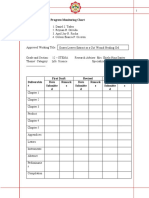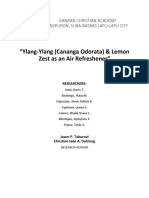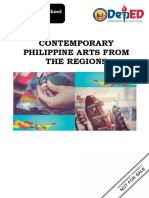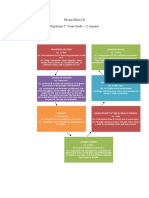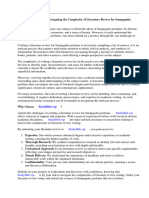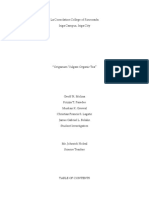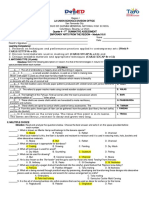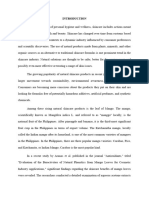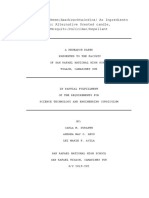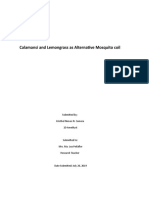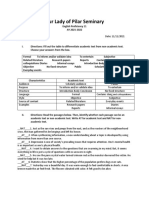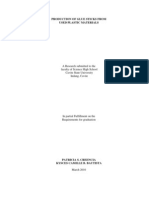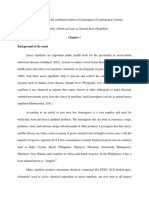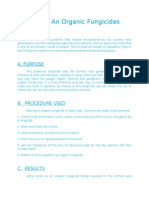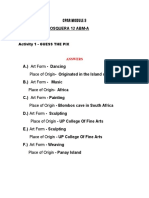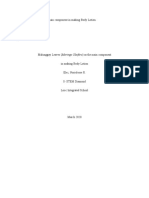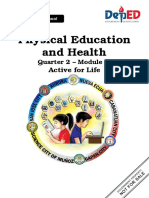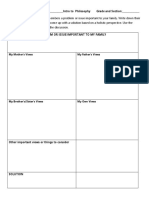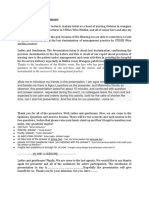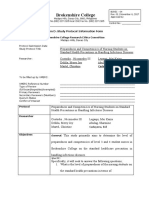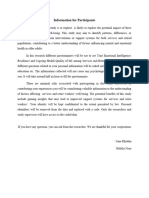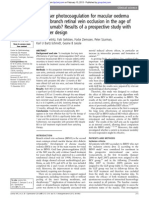CHAPTER I
INTRODUCTION
Background of the Study
The increasing demand for healthy snack alternatives has spurred
interest in incorporating nutrients plants into processed foods. Malunggay
(Moringa Oleifera), is a tropical plant renowned for its high nutritional value,
including vitamins A, C, and E, as well as essential minerals and antioxidants.
Traditionally used in various culinary applications, Malunggay leaves have
potential beyond the conventional uses, particularly in the development of
snack foods. This study aims to explore the effectiveness of Moringa leaves
as an alternative to traditional chips, examining aspects such as nutritional
benefits, taste, texture, and consumer acceptability. By investigating the
feasibility of Moringa-based chips, the research seeks to contribute to the
growing field of functional foods, promote sustainable agricultural practices,
and provide healthier snack options to consumers.
1
�Statement of the Problem
The general problem of the study is to examine the effectiveness of
malunggay leaves as an alternative chips. This aim is to look at how Moringa
leaves can be when made into chips. It will focus on the nutritional value,
taste, texture, and whether people like these chips or used for business.
The study sought to answer the following questions:
1.) How do taste, texture, and overall acceptance of Malunggay leaf
chips compare to traditional chips?
2.) What preparation methods yield the most palatable and shelf-stable
Malunggay leaves chips, and what is the nutritional value of this chips?
3.) Are people interested in buying or trying Malunggay chips, and what
might stop them from doing so?
4.) Which groups of people (age, gender) are most likely to try
Malunggay chips?
2
�Objectives of the Study
This study especially aims to:
1. To investigate the feasibility of processing Malunggay leaves into a
chip product, including the methods of preparation, and cooking or
drying.
2. To develop and test various recipes for malunggay chips, exploring
different preparation methods and seasoning options to enhance flavor
and appeal.
3. To examine consumer awareness and acceptance of malunggay leaf
chips, including preferences for flavor, pricing, and packaging.
4. To analyze the nutrient composition of malunggay leaves compare it
with traditional chip ingredients.
5. To study if this chips product is good for snacks and for businesses.
3
�Significance of the Study
This research will be conducted to determine the effectiveness of
malunggay leaves as an alternative chips. Benefitting the study are the
various sectors as follows:
People. This study could significantly impact individual dietary
choices by introducing a nutritious snack option. Moringa leaves can provide
essential vitamins and minerals, which could improve health outcomes for
people looking for healthier alternative chips.
Nutrition. The study highlights the potential of Moringa leaves to
provide essential nutrients that are often lacking in processed snacks. By
incorporating Moringa chips into diets, the research could lead better overall
public health, and increased awareness of the importance of incorporating
superfoods into everyday diets.
Businesses. This research opens avenues for new product
development and market expansion. Companies can innovate by creating
Moringa-based chips snacks, tapping into the growing health food market.
Local farmers can also earn more by growing Moringa, boosting the local
economy.
Future Researcher. This research can serve as a foundation for
future studies on Moringa and its application. It may inspire other researchers
to explore its health benefits, production methods, or market potential,
contributing to a broader understanding of this valuable plant.
4
� Community. This study can promoting the use of moringa as a
snack can foster local agriculture and sustainability. By encouraging the
cultivation of Moringa, communities can enhance food security, create local
jobs, and promote environmental benefits.
Scope and Delimitations of the Study
The researcher conducted this study entitled “Examining the
Effectiveness of Malunggay (Moringa Oleifera) Leaves as an Alternative
Chips”. The study will explore the use of Malunggay leaves as a primary
ingredient for making chips. It will analyze the nutritional content of Malunggay
chips in comparison to traditional chips, while also surveying consumer
preferences related to taste, texture, and overall acceptance among different
age groups. This will help determine if they enjoy them as a snack and if they
think they could be good product for business. The study will also explore
different ways to cook and prepare Malunggay chips to find the best method.
The research will take place in a specific local area, like community or school.
The researchers will conduct the data gathering through
questionnaire or survey and face-to-face interaction. The number of people
involved in surveys will be small, which might not reflect the views of
everyone. While the study will look at what people think about the health
benefits, it won’t conduct deep scientific test to confirm these claims. They will
also be collecting some documents that will serve as evidence and justify and
5
�confirm the result made from the questionnaires and that will help them to
formulate a precise and well established conclusion.
Participants and Locale of the Study
This study was conducted at The Notre Dame of Esperanza Inc. The
place in specific local area, like community or school was selected for
knowing the effectiveness of Moringa leaves as an alternative chips. The
preparation of methods and seasoning options might be examine at
researchers own place. This study will be implemented by students, teachers,
and random people of the said place.
6
� CHAPTER II
REVIEW OF RELATED LITERATURE
This chapter presents a review of related literature and studies that
were relevant to the research study to provide readers with additional context
and knowledge. The chapter also includes further references that will aid in
the interpretation of the research results.
Related Literature
Snacking has long been ingrained in our daily lives, forming a crucial
part of our diet and cravings. Chips, for instance, are portable and enjoyed in
various settings like cinemas, during TV time, while doing homework, or
simply to curb boredom. Their versatility has led to a wide array of chip
varieties available today, fueling a thriving industry. However, despite their
popularity, chips are often classified as junk food and are notorious for their
potential health risks. Numerous health resources highlight chips as one of
the worst foods one can consume, underscoring their negative impact on
health.
In response to these concerns, researchers sought to develop a
healthier alternative: Malunggay Chips, made from nutritious Moringa oleifera
leaves. These chips aim to offer a delicious snack without harmful chemicals,
providing a viable option for both children and adults who enjoy snacking. The
goal is to create a product that not only satisfies cravings but also promotes
health and well-being, appealing to a wide audience looking for nutritious,
affordable, and tasty snack choices.
7
� Moringa (Moringa oleifera Lam.) is originally from the Indian
subcontinent and has become established in tropical and subtropical regions
worldwide. It is known by various regional names, including Benzolive,
Drumstick tree, Horseradish tree, Kelor, Marango, Mlonge, Mulangay,
Saijihan, and Sajna (Fahey, 2005). This plant thrives in a tropical insular
climate and can grow well in humid tropical areas or hot, dry lands, adapting
to less fertile soils and showing resilience to drought (Anwar et al., 2007).
Recognized as one of the most beneficial trees globally, nearly every part of
the Moringa tree is utilized for food, medicine, and industrial applications
(Khalafalla et al., 2010). Its leaves, flowers, and fresh pods are consumed as
vegetables, and it is also used as livestock feed (Anjorin et al., 2010). Moringa
has the potential to enhance nutrition, strengthen food security, and promote
rural development (Hsu, 2006).
Research by Yang’s group (2006) indicated that Moringa oleifera is a
promising crop that can enhance the intake of micronutrients and
antioxidants. The World Health Organization has also endorsed moringa as a
substitute for imported food sources to address malnutrition (Sreelatha and
Padma, 2009; Johnson, 2005).
Most studies investigating the effectiveness of Moringa oleifera in
improving the nutritional and hematological status of malnourished individuals
have focused on very young children. Research in Burkina Faso (Compaoré
et al., 2011) showed that infants gained weight when given complementary
8
�foods mixed with moringa seeds, while a study in Uganda (Jilcott et al., 2010)
found similar results with moringa leaf powder.
In the Philippines, Moringa oleifera is widely known as Malunggay. Its
leaves rank among the top 30 food items consumed by Filipinos (Food and
Nutrition Research Institute-Department of Science and Technology (FNRI-
DOST), 2010a, b). For children aged 6 to 12 years, the average consumption
of Malunggay is 15 grams per day.
Malunggay leaves (Moringa oleifera) are a key ingredient in many
beloved Filipino dishes (Vince Madrid, Fil-Kitchen II, 2018). This plant is
widely available throughout the Philippines, thriving even in urban and remote
areas—often seen growing along sidewalks. It's highly nutritious and
accessible, prompting the Department of Health (DOH) to recommend it as
part of the daily diet. Malunggay is commonly used in soup-based dishes like
tinola, sinigang, and pesa. Filipino mothers often find creative ways to include
it in meals for their children, who are typically picky about vegetables. To
encourage kids to eat healthier, mothers might add malunggay to popular
foods such as burgers, fried dishes, and siomai.
Moringa oleifera is one of the most well-known medicinal plants. It has
been consumed by humans for its rich content of vitamins A, B, C, D, E, and
K. Additionally, it contains essential minerals such as calcium, copper, iron,
potassium, magnesium, manganese, and zinc (Dan Malam, The Nature and
Health, 2014). With over 40 natural antioxidants, Moringa has been utilized
9
�since 150 B.C. by ancient royalty for mental clarity and healthy skin. Its
various parts—leaves, pods, seeds, gums, bark, and flowers—are used in
more than 80 countries to address mineral and vitamin deficiencies, support
cardiovascular health, regulate blood glucose levels, neutralize free radicals,
enhance the body’s anti-inflammatory response, improve blood quality, and
boost the immune system.
Moringa also aids in improving eyesight, mental focus, and bone
strength. Its potential benefits extend to malnutrition, general weakness,
lactating mothers, menopause, depression, and osteoporosis. Furthermore,
Moringa can be used as an efficient fuel source, fertilizer, and livestock feed.
The leaves are recognized as a valuable source of nutrition and an organic
health supplement with various therapeutic applications.
Malunggay leaves are rich in vitamins A, B, C, D, and E, as well as
amino acids, cysteine, and essential minerals like calcium, phosphorus, iron,
and magnesium. Nutritionists assert that, ounce for ounce, malunggay
contains seven times more vitamin C than oranges, four times more vitamin A
than carrots, four times the calcium and double the protein of milk, and three
times the potassium found in bananas (Henrylito D. Tacio, The Book of Plants
and Dietetics, 2014). Due to its impressive nutritional profile, nutritionists and
dietitians recommend malunggay as a substitute for various traditional
ingredients.
10
� The “Diffusion of Innovation Theory” by Thurber and Fahey (2010)
clarifies the recent rise in the adoption of Moringa Oleifera by various
international organizations and specific groups within undernourished
populations. This theory has similarly proven effective in explaining the
adoption of innovative agricultural practices from the 1940s to the 1960s.
Malunggay pods are reported to be effective against intestinal
parasites. A decoction made from boiled malunggay roots can relieve
hoarseness and sore throat when used as a gargle, and it can help dry sores
and ulcers due to its antibacterial properties (Dr. Ubi, Benjamin Ewa, Herbs,
2016). Almost every part of the tree can be utilized, including the roots, pods,
and oil extracts, in various medicinal applications. Often referred to as the
“second tree of life” (with the coconut being the first), malunggay offers a wide
range of uses and benefits. Therefore, it’s recommended that every
household have at least one malunggay plant in their garden.
Malunggay is found in many countries, even in regions with
extreme weather conditions, which is why it’s not unusual to see a drumstick
tree at the foot of the Himalayan mountain ranges. There, it is commonly used
to treat various ailments, including iron and vitamin deficiencies, as well as
lactose intolerance. In remote areas where access to conventional medicine is
limited, malunggay is often relied upon as a natural or herbal remedy.
Additionally, it is reported to be used in tribal rituals and ceremonies among
different communities.
11
�Related Studies
Moringa is a cultivated variety within the genus Moringa and
belongs to the Moringaceae family. It is utilized in over 80 countries, including
Pakistan, to address mineral and vitamin deficiencies, support cardiovascular
health, and potentially combat malnutrition (Coppin Julia, 2014). Often
referred to as the “wonder plant,” Moringa is celebrated for its remarkable
nutritional value packed into a small, easy-to-prepare form. It is abundant in
vitamins, minerals, amino acids, and other nutrients that aid in body
development and reduce the impact of various diseases. Known as
malunggay, Moringa is easily cultivated and thrives in diverse environments,
with studies indicating its resilience to extreme weather conditions, including
drought and winter.
Moringa oleifera is a significant multipurpose tropical tree known for
its nutritional and medicinal benefits. Research indicates that Moringa
possesses anti-cancer properties, likely due to the bioactive compounds
found in its extracts (Abdulrahman Khazim, 2015). Malunggay has been
studied globally for its health benefits, leading to various scientific
advancements in medicine and dietetics. Modern bioengineering has
enhanced the effects of malunggay, revealing its potential in cancer
treatment.
This is attributed to various bio-minerals that target cancer cells,
which are also found in foods like apples, bananas, pears, carrots, and celery.
12
�With today’s scientific advancements, malunggay continues to make strides in
bioengineering and is expected to play a significant role in multiple research
fields.
Moringa, commonly referred to as the drumstick tree, originates
from the southern foothills of the Himalayas in Northwest India, where it is
integrated into the local diet. The properties and nutrients found in moringa
can help address various deficiencies and health issues (Ruchita Haldar,
2017).
“Malunggay” in the Philippines, “Shajina” in the Indian subcontinent,
and “Moringa” in English are names for a widely popular tree. Many people in
Asia use malunggay leaves similarly to spinach and consume its fruit as a
vegetable, much like asparagus. Initially recognized primarily as a vegetable
for lactating mothers, recent scientific studies have highlighted malunggay’s
medical potential and benefits. Often referred to as a “Miracle Vegetable,” it
has been promoted by the World Health Organization (WHO) for over 20
years as a low-cost health enhancer in developing countries.
Malunggay leaves are rich in antioxidants, which can help prevent
lifestyle-related diseases such as cardiovascular issues, high blood pressure,
and cancer. Recent studies compare the protein content in leaves from
different varieties of Moringa trees grown worldwide, allowing for estimates of
optimal leaf extract use. Research conducted by Suleyman (2009) suggests
that malunggay is one of the most promising discoveries of this millennium,
13
�now widely used across the globe. This study aimed to identify a unique filling
made from the nutrient-rich Moringa oleifera.
According to Philippine Herbal Medicine.org, malunggay is
recognized for its anti-diabetic and anti-tumor properties. There are claims
that it can help lower blood pressure and act as an anti-tumor agent.
Additionally, the Biotechnology Program Office of the Department of
Agriculture has found that malunggay is rich in vitamins A and C, iron, and
high-density lipoprotein (good cholesterol), as noted by biochemists and
molecular anthropologists. Gram for gram, malunggay leaves are packed with
nutrients and contain twice the protein found in milk.
The bill was authored by Gena de Venecia, the representative for
Pangasinan’s fourth district and an Ilocana who grew up eating malunggay
several times a week. In her legislation, she highlighted the economic,
nutritional, and medicinal advantages of the vegetable. “For years, malunggay
has been viewed as just a backyard plant in the Philippines. Now, we can
assert that it has the potential to save lives, boost incomes, create millions of
jobs, make effective use of extensive agricultural lands, enhance the
Philippines’ global competitiveness, influence both local and international
markets, and contribute to socioeconomic equity.”
“Malunggay is a crucial plant that warrants national and
international promotion because of its significant biomedical contributions and
14
�various socioeconomic benefits. Additionally, it can serve as a valuable tool in
combating malnutrition in the Philippines.”
According to ECHO (2007), in the Philippines, Moringa leaves,
commonly known as “malunggay,” are cooked and served to babies, earning
the nickname “mother’s best friend.” Studies have reported that Moringa
possesses anti-tumor properties, largely attributed to the presence of benzyl
isothiocyanate. Numerous research efforts have highlighted the
chemoprotective and anti-cancer effects of these compounds, which are
particularly beneficial for individuals undergoing chemotherapy as they help
strengthen cells. Malunggay is also recognized for its role in treating skin and
prostate cancer (Ref: ECHO Development Notes #68, June 2000; Fuglie LJ,
2000). Furthermore, research from the late 1940s at the Indian Institute of
Science in Bangalore (PLN Rao) identified a compound in malunggay leaves
called “pteridosperm,” known for its antibacterial, antimicrobial, and antifungal
properties. Additionally, malunggay leaf tea is noted for its effectiveness in
managing diabetes.
Synthesis
The researchers aim to develop a new variant of chips that is both
healthy and affordable. Despite the growing and evolving chips industry,
which often poses health risks, the team seeks to create a nutritious and safe
alternative.
15
� According to Weber (2015), the salty snack market is largely
dominated by potato chips, with sales reaching $7.23 billion, highlighting the
public’s love for their crispiness. However, studies by Mercola (2003), Ell
(2013), and Beiz’s group (2013) indicate that chips can be detrimental to
health due to harmful substances they contain, such as BHT and acrylamide.
Ell (2013) characterized chips as nutrient-poor. Given these concerns, the
researchers believe that Malunggay Chips can cater to snack enthusiasts.
With malunggay leaves—often referred to as the “Miracle Vegetable” by
Marero (2004)—as the primary ingredient, these chips will provide a delicious
snack option without the health risks typically associated with conventional
chips.
Moringa offers numerous benefits, as noted by HDRA (2002). It is
rich in nutrients and vitamins, and all parts of the tree can be utilized in
various ways. Several factors influence Moringa’s growth, including rainfall,
altitude, temperature, and soil conditions. It thrives best at altitudes of around
600 meters but can also grow at elevations up to 1000 meters (HDRA, 2002).
The seeds of malunggay are known to purify water; a study by Justin Yatco et
al. (2016) found that malunggay seeds can effectively cleanse dirty water.
Additionally, malunggay leaves play a vital role in the body’s metabolism. One
of their key benefits is the effectiveness of malunggay leaf tea in treating
diabetes, as well as its ability to boost the immune system.
16
� CHAPTER III
METHODOLOGY
A. Locale
The study was conducted in the Notre Dame of Esperanza, Inc.
B. Respondents
The respondents are composed of students, teachers of the Notre Dame of
Esperanza, Inc. and random people in a community, surveying or having a
face-to-face interaction of some of the students, teachers, and random people
in the said school and community.
C. Research Design
This study used a survey research design because it is best way to get the
answers to the questions and purposes of the study. The survey research is
one which a group of people studied by collecting and analyzing data from the
students, teachers, and random people in a community. This study also made
use of the experimental design form of research that will study the Malunggay
leaves or Moringa Oleifera as an alternative chips. Since the present study is
concerned with the malunggay leaves as an alternative chips, the
experimental method is the most appropriate to use.
17
�Materials
A. Utensil/Equipment
● Knife
● Tablespoon
● Chopping board
● Mixing bowl
● Tray
● Oven
● Frying pan
B. Procedure:
1. Collect and harvest fresh leaves of Malunggay. Wash the malunggay
leaves.
2. Slice into thin pieces until you make 1 or ½ cup.
3. Put them in a mixing bowl and add seasonings. It’s up to you what kind of
seasonings based in your taste.
4. Add 1 cup of cold water and mix it well. After that add a small cubes of ice
because that is the secret to make it crunchy and crispy.
5. Prepare the frying pan with oil in the stove so that we can fry the
malunggay mixture as a chips.
6. When it’s time to fry, just put a small amount of mixture or 1 tablespoon.
After that you are now have a malunggay chips. You can put it into tissue
paper so it can absorbed the oil.
18
�7. If you more crispiness of the chips you can put in the oven. Just observe to
avoid burn the chips.
D. Data Gathering Plan
The researchers decided to have a survey on the students and teachers of
the Notre Dame of Esperanza, Inc. to verify the researcher's conclusions. The
researchers also to have a survey on the random people in a different
community. The researchers will furthermore analyze and conclude with
supporting details.
E. Statistical Analysis
The data gathered will be tallied, tabulated, and analyzed using frequency
and percentage which will be used in answering the research questions.
F. Research Tool
Below are the questions that the researchers formulated to support the
research study.
Age _____
Male ___ Female ___
1. Have you ever tried Malunggay chips?
___ Yes ___ No
2. How do you rate the taste of Malunggay chips?
___ Very good ___Good ___ Okay ___ Bad
3. What do you like most about Malunggay chips? (You can choose 2 or
more)
___ Taste/flavor ___ Health benefits ___ Crunchiness ___
none
4. Would you choose Malunggay chips over regular chips?
___ Yes ___ No ___ Maybe
19
�5. Do you think Malunggay leaves should be promoted more as a snack?
___ Yes ___ No ___ Maybe
6. Do you think Malunggay chips is good for a business and as a new
product?
___ Yes ___ No ___ Maybe
CHAPTER IV
DATA PRESENTATION, ANALYSIS, AND INTERPRETATION
This chapter contains the presentation of result, analysis, observation
after the conduct of the experiment and interpretation of data gathered from
the survey questionnaire of the study. It also contains evidences (e.g. charts,
pictures) that further support the result of the study.
Figure 1. Presents the methods of making the malunggay chips.
Figure 1. Malunggay Chips Process
20
� Table 1
GENDER NO. OF PEOPLE
Female 13
Male 7
TOTAL 20
This table shows the total number of random people who participated in
a survey about the study. There are 13 women and 7 men with the total of 20
people.
Table 1.2
AGE FREQUENCY
17 years old 11
18 years old 6
19 years old 1
34 years old 1
40 years old 1
TOTAL 20
The table 1.2 indicates that twenty (20) of people actively participated
on the survey questionnaire, the table shows that majority of people are
seventeen (17) years old which is 11 people, while the eighteen (18) to
nineteen (19) years old is 7 people, and only 1 of people who participated that
is 34 years old and 40 years old.
21
� Have you ever tried
Malunggay chips?
The Rate of the Taste of Malunggay YES 17
chips NO 3
Total 20
Okay
15%
Very good This pie chart
35%
How do you rate the taste
of Malunggay chips?
Good
50% Very good 7
Good 10
Very good Good Okay Bad Okay 3
shows that the majority of the students answered YES, 85% Bad 0
or 17 of them that want or already tried malunggay chips.
Total 20
And there are 15% or 3 of them answer of NO, which means
only few of people is first time to try the malunggay chips.
As shown in the pie chart above, it is the rate of the taste of malunggay
chips. From the given answer of respondents, the majority is (17 out of 20) or
85% rated the taste of malunggay chips as either “Very Good” or “Good”. Only
3 or 15% people rated them as “Okay”, and nobody rated them as “Bad”. This
shows that generally is positive response to the taste of malunggay chips.
What do you like most about Malunggay
What do you like most
about Malunggay chips?
Taste/Flavor 14
Health 17
Have you ever tried Malunggay chips? benefits
Crunchiness 5
15%
none 0
85%
YES NO
22
� Would you choose Malunggay chips
over Regular chips?
MAYBE 11
Other than
that, the
NO 2 researcher also
would like to know
YES 7 what they like
most about
PEOPLE malunggay chips
Would you choose
after they consume the chips, there are 4 options for the Malunggay chips over
respondent to choose and they can choose 2 more options. regular chips?
From the given answer, the highest vote is the health Yes 7
benefits of the chips which is 17 or 85% of people. The No 2
malunggay (moringa oleifera) is have different health benefits
Maybe 11
since it is full of vitamins, etc. Another is taste or flavor which
is the second highest vote that is 14 or 70% of people while 5 Total 20
or 25% vote for crunchiness and no one answer of NONE.
18 1200%
16 Do you think malunggay leaves should be promoted
as snack? 1000%
14
12 Maybe This table shows
800%
15%
10 the number of
600% people who think
8
or choose that the
6 400% malunggay chips
4 is good or best
200%
2 Yes rather than the
85% regular chips like
0 0%
Taste/Flavor Health benefits Crunchiness None potato, etc.
Based on the
chart, most of them or 11 choose that maybe malunggay chips is better than
regular chips this might be that they are not sure the difference between
malunggay chips and regular chips that need more experiment or observation.
While 7 of them choose that malunggay chips is better than regular chips and
2 of people choose the regular chips.
Do you think Malunggay
leaves should be promoted
more as a snack?
Yes 17
23 No 0
Maybe 3
Total 20
� D o y Ou t h in k ma lu n g g a y c h ip s is g o o d fo r
This table
b u s in e s s a n d a s n e w p r o d u c t ? shows the number
of people who
believe or think that
malunggay leaves
should be promoted
16
as snack. Based in
4 the given answer,
0
Do you think Malunggay
YES NO MAYB E chips is good for a
business and as a new
People
product?
majority of them think that is should be promoted as a Yes 16
snack which is 17 or 85% of them have answered YES. No 0
On the other hand, only 3 answered MAYBE and no one
Maybe 4
answered NO. This shows that malunggay leaves can be
good to make a snack especially that it can easily to Total 20
make.
The chart interpret that the malunggay chips is good for business and
as new product. In this chart, most of people think that it is good for business
and new product which has 16 votes of people. Second, 4 of them stated that
the malunggay chips can be good for business or as new product and no one
answer of NO.
24
� CHAPTER V
SUMMARY, CONCLUSIONS, RECOMMENDATIONS
This chapter presents the summary, conclusions, and recommendation
of the study.
Summary and Conclusions
This study investigated the potential of Malunggay (Moringa Oleifera)
leaves as a healthier alternative to traditional chips. By analyzing the
nutritional content, sensory qualities, and consumer preferences, the research
highlighted the benefits of Moringa chips, which are rich in vitamins, minerals,
and antioxidants. The study utilized various preparation methods to enhance
the flavor and texture of the chips, ultimately comparing them to conventional
options. Findings revealed that Moringa chips not only provide superior
nutritional value but also received favorable responses from taste testers,
indicating their potential as a marketable snack.
Based on the result of the study, the research confirms that Malunggay
(Moringa Oleifera) leaves are an effective alternative to traditional chips,
offering enhanced nutritional benefits and appealing sensory attributes. The
positive consumer feedback suggests that Moringa chips could fill a niche in
the growing market for healthier snacks. This study contributes to the ongoing
exploration of underutilized crops and their role in promoting better dietary
choices.
25
�Recommendation
Further research is recommended to explore the commercial feasibility
of Moringa chips, including shelf-life studies and market analysis. Additionally,
developing diverse flavor profiles and packaging strategies could enhance
consumer appeal. Collaboration with local farmers and food entrepreneurs
may also facilitate the sustainable production and distribution of Moringa
chips, promoting both health and local agriculture.
26





